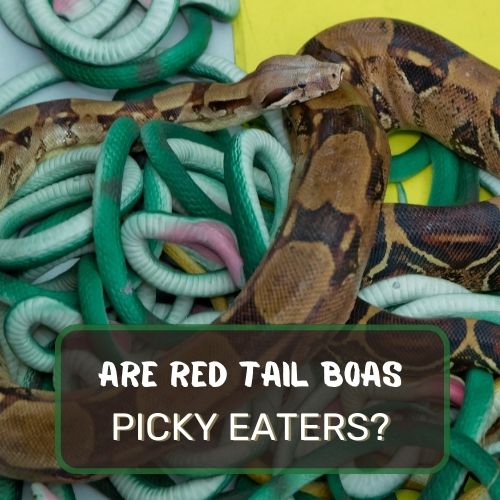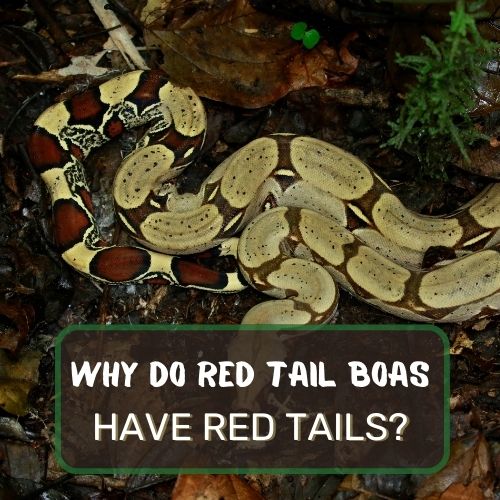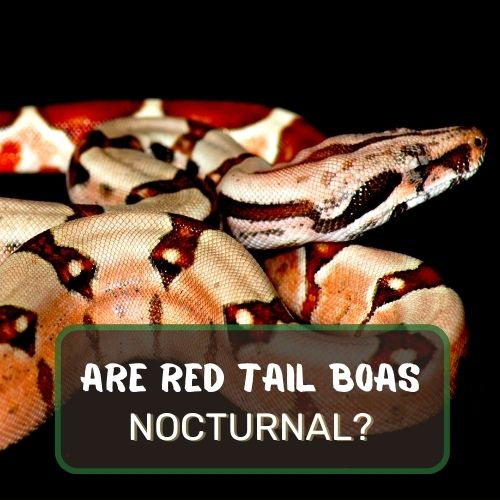Welcome to this comprehensive guide on a question that’s piqued the curiosity of many Red Tail Boa owners: Can these fascinating snakes eat rabbits?
Yes, adult Red Tail Boas can eat rabbits, but there are factors to consider. Rabbits offer good nutritional value and can be an appropriate meal size for larger boas. However, they can also carry parasites and may pose ethical concerns.
In this article, we’ll delve into the natural diet of Red Tail Boas, explore the pros and cons of feeding them rabbits, and even touch on their overall nutritional needs. We’ll also offer some practical feeding guidelines and discuss alternative food options.
Plus, we’ll tackle some other burning questions you might have about these incredible creatures. So, buckle up and let’s get started on this intriguing journey into the world of Red Tail Boas!

Table of Contents
What Do Red Tail Boas Eat in the Wild?
These creatures are native to a range of environments, from tropical rainforests to arid scrublands. And guess what? Their diet is as diverse as their habitats.
Carnivorous Tendencies and Varied Diet
Primarily, Red Tail Boas are carnivorous, and they’re not too fussy about what’s on the menu. Small to medium-sized mammals like rodents are their go-to, but they also have a taste for birds and occasionally other reptiles.
Imagine being a mouse, just going about your day, and then—BAM!—you’re a meal.
It’s a tough world out there.
The Art of Ambush Predation
Ambush predators by nature, these boas use their keen senses to detect movement and heat. Once they’ve got a target, they strike with incredible speed, wrapping their muscular bodies around their prey and squeezing until, well, dinner is served. It’s not a pretty sight, but it’s effective.
Size Matters: Prey Selection Based on Boa Size
The size of their prey usually correlates with their own size. So, while a young Red Tail Boa might be content with a diet of small mice or rats, a full-grown adult could tackle something as sizable as a monkey or an opossum.

The Pros of Feeding Rabbits to Red Tail Boas
Nutritional Value
First off, let’s talk about the good stuff. Rabbits are chock-full of nutrients that can be beneficial for a Red Tail Boa. They offer a good balance of protein and fat, which can be especially beneficial for adult boas that require a more substantial meal.
Size Compatibility
For a fully grown Red Tail Boa, a rabbit can be a meal that’s just the right size. It’s not too small to be insignificant, and not too large to pose a risk of choking or digestive issues.
In essence, it’s like the Goldilocks of prey items for adult boas.
Variety is the Spice of Life
Feeding your Red Tail Boa a rabbit occasionally can add some much-needed variety to their diet. Just like humans enjoy different foods, a change in diet can be stimulating for a snake and can contribute to its overall well-being.
Easier to Source
Believe it or not, rabbits are often easier to source than other types of prey, especially if you’re living in a rural area. This can make your life a bit easier when it comes to feeding time.

The Cons of Feeding Rabbits to Red Tail Boas
Potential Health Risks
Now, let’s flip the coin. Feeding rabbits to your Red Tail Boa isn’t without its risks. For starters, rabbits can be carriers of parasites or diseases that could potentially be transferred to your snake.
Ethical Concerns
There’s also the ethical aspect to consider. Rabbits are more complex animals with higher cognitive functions compared to rodents.
Some people argue that feeding such animals to snakes raises ethical questions that shouldn’t be ignored.
Cost Factor
Rabbits aren’t cheap. If you’re thinking of making rabbits a regular part of your Red Tail Boa’s diet, be prepared for the added expense. It can quickly add up, especially if you have a large snake that needs frequent feeding.
Digestive Challenges
Last but not least, rabbits have a different bone-to-muscle ratio compared to rodents. This could pose a challenge for your snake’s digestive system, especially if it’s not used to such a diet.

Nutritional Requirements of Red Tail Boas
Protein: The Building Block of Life
Alright, let’s get into the meat of the matter—literally. Protein is a big deal for Red Tail Boas. It’s essential for their growth, muscle development, and overall vitality.
In the wild, they’re feasting on protein-rich prey like rodents and birds, so it’s crucial to mimic this in captivity.
Fats: The Energy Source
Fats are the next item on the nutritional checklist. While they shouldn’t make up the bulk of the diet, they are essential for providing energy.
Too much fat, however, can lead to obesity, which is a growing concern among captive snakes. So, balance is key.
Vitamins and Minerals: The Unsung Heroes
You might not think of vitamins and minerals when planning a snake’s diet, but they’re vital. Calcium, for instance, is crucial for bone health, especially for growing snakes.
Phosphorus, zinc, and other trace minerals also play a role in metabolic functions and overall health.
Hydration: More Important Than You Think
Water is often the overlooked component in a snake’s diet. A constant supply of fresh, clean water is essential for digestion and hydration. It’s not just about the food; water plays a significant role in a snake’s overall well-being.
The Role of Variety
Last but not least, variety is essential. Just like you wouldn’t want to eat the same thing every day, neither does your snake. A varied diet can provide a broader range of nutrients and also keep your snake more engaged with its food.
So, there you have it—a comprehensive look at the nutritional needs of a Red Tail Boa. It’s not as simple as throwing any prey item into the enclosure. It’s about understanding what makes a balanced, nutritious diet that will help your snake thrive in captivity.

Feeding Guidelines for Red Tail Boas
How Often Should You Feed?
The million-dollar question: How often should you feed your Red Tail Boa? Well, it depends on age and size. Younger snakes usually require more frequent meals, like once a week. Adult boas, on the other hand, can go up to two weeks between feedings.
The Right Size of Prey
Size does matter when it comes to feeding your boa. The prey should be roughly the same width as the widest part of your snake’s body. This ensures easier digestion and minimizes the risk of choking or regurgitation.
Live vs. Frozen: The Eternal Debate
Ah, the age-old debate: live prey or frozen? While live prey can stimulate your snake’s natural hunting instincts, frozen prey is often safer. It eliminates the risk of your snake getting injured by a struggling animal and is usually free from parasites.
Monitoring After Feeding
Don’t just feed and forget. Always monitor your snake post-feeding. Look for signs of distress like regurgitation or lethargy. If something seems off, it might be time to reassess your feeding strategy or consult a vet.

Other Food Options for Red Tail Boas
Rats and Mice: The Staple Diet
Rats and mice are the bread and butter of a Red Tail Boa’s diet. They’re easy to find, rich in nutrients, and come in various sizes to suit snakes of all ages.
Guinea Pigs: An Occasional Treat
Guinea pigs can also be an option, especially for larger boas. They offer a different nutrient profile and can add variety to the diet. However, they should be fed sparingly due to their higher fat content.
Chickens and Quails: For the Adventurous Boa
Believe it or not, some boas also enjoy birds like chickens and quails. These can be a good source of lean protein but should be introduced gradually to see how your snake reacts.
Fish: Proceed with Caution
Some owners have experimented with feeding fish to their Red Tail Boas. While this can provide some variety, be cautious. Fish can carry parasites and lack some essential nutrients when compared to mammals.
Insects: Not Recommended
While some reptiles thrive on a diet of insects, they’re generally not recommended for Red Tail Boas due to their low nutritional value.
Conclusion
You’ve journeyed through the intriguing world of Red Tail Boas and their dietary habits. We’ve explored what these captivating creatures eat in the wild, weighed the pros and cons of feeding them rabbits, and even delved into their nutritional needs.
You’ve also gained insights into practical feeding guidelines and alternative food options. Armed with this knowledge, you’re well-equipped to make informed decisions about your Red Tail Boa’s diet.
Remember, the key to a healthy snake is a balanced diet and responsible care. So go ahead, apply what you’ve learned, and here’s to a happy, healthy life for your slithery friend!
FAQ
Can Boa Constrictors Eat Rabbits?
Ah, the question that’s probably on many minds: Can boa constrictors, in general, eat rabbits? The answer is yes, especially for larger, adult boas. However, it’s crucial to consider the size of both the snake and the rabbit, as well as any potential health risks like parasites.
What Do Red-Tailed Boas Eat?
We’ve touched on this, but to reiterate, red-tailed boas have a varied diet that primarily includes small to medium-sized mammals like rodents. Birds and other reptiles can also be on the menu, especially in the wild.
Are Red Tail Boas Picky Eaters?
You might wonder if these snakes are the finicky type. Generally speaking, Red Tail Boas are not picky eaters. They’re opportunistic predators, happy to eat what’s available. However, individual preferences can vary, so it’s always good to monitor your snake’s eating habits.




0 Comments